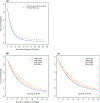Survival Outcomes Among Patients with Metastatic Breast Cancer: Review of 47,000 Patients
- PMID: 34050430
- PMCID: PMC8530869
- DOI: 10.1245/s10434-021-10227-3
Survival Outcomes Among Patients with Metastatic Breast Cancer: Review of 47,000 Patients
Abstract
Background: Although metastatic breast cancer (MBC) remains incurable, advances in therapies have improved survival. Using a contemporary dataset of de novo MBC patients, we explore how overall (OS) and cancer-specific survival (CSS) changed over time.
Methods: All patients with de novo MBC from 1988 to 2016 were selected from Surveillance, Epidemiology, and End Results (SEER) 18. Unadjusted OS and CSS were estimated by Kaplan-Meier method and stratified by disease characteristics. Cox proportional hazards models determined factors associated with survival.
Results: 47,034 patients were included, with median OS of 25 months and CSS of 27 months. Survival steadily improved over time (1988: 1-year OS 62%, CSS 65%; 2015: 1-year OS 72%, CSS 74%). Patients with triple-negative breast cancer (TNBC) had the worst prognosis and were most likely to die from MBC [versus human epidermal growth factor receptor 2 (HER2)+ and hormone receptor (HR)+/HER2-]. Those with ≥ 4 sites of metastatic disease were also more likely to die from MBC with nearly identical OS and CSS (5-year OS 9%, CSS 9%), when compared with those with 1 site (5-year OS 31%, CSS 35%). After adjustment, improved CSS was associated with bone-only disease [hazard ratio (HR) 0.88, 95% confidence interval (CI) 0.83-0.94], while TNBC (versus HER2+: HR 3.12, 95% CI 2.89-3.36) and > 3 sites of metastatic disease (versus 1 site: HR 3.24, 95% CI 2.68-3.91) were associated with worse CSS (all p < 0.001).
Conclusions: Accurate prognostic estimates are essential for patient care. As treatments for patients with MBC have expanded, OS and CSS have improved, and more patients, particularly with limited distant disease or favorable tumor subtypes, are also dying from non-MBC causes.
© 2021. Society of Surgical Oncology.
Figures





References
-
- Siegel RL, Miller KD, Jemal A. Cancer statistics, 2020. CA Cancer J Clin. 2020;70(1):7–30. - PubMed
-
- Miller KD, Nogueira L, Mariotto AB, et al. Cancer treatment and survivorship statistics, 2019. CA Cancer J Clin. 2019;69(5):363–85. - PubMed
-
- Beslija S, Bonneterre J, Burstein HJ, et al. Third consensus on medical treatment of metastatic breast cancer. Ann Oncol. 2009;20(11):1771–85. - PubMed
-
- Schmid P, Adams S, Rugo HS, et al. Atezolizumab and nab-paclitaxel in advanced triple-negative breast cancer. N Engl J Med. 2018;379(22):2108–21. - PubMed
-
- Barinoff J, Schmidt M, Schneeweiss A, et al. Primary metastatic breast cancer in the era of targeted therapy—prognostic impact and the role of breast tumour surgery. Eur J Cancer. 2017;83:116–24. - PubMed
MeSH terms
Grants and funding
LinkOut - more resources
Full Text Sources
Other Literature Sources
Medical
Research Materials
Miscellaneous

